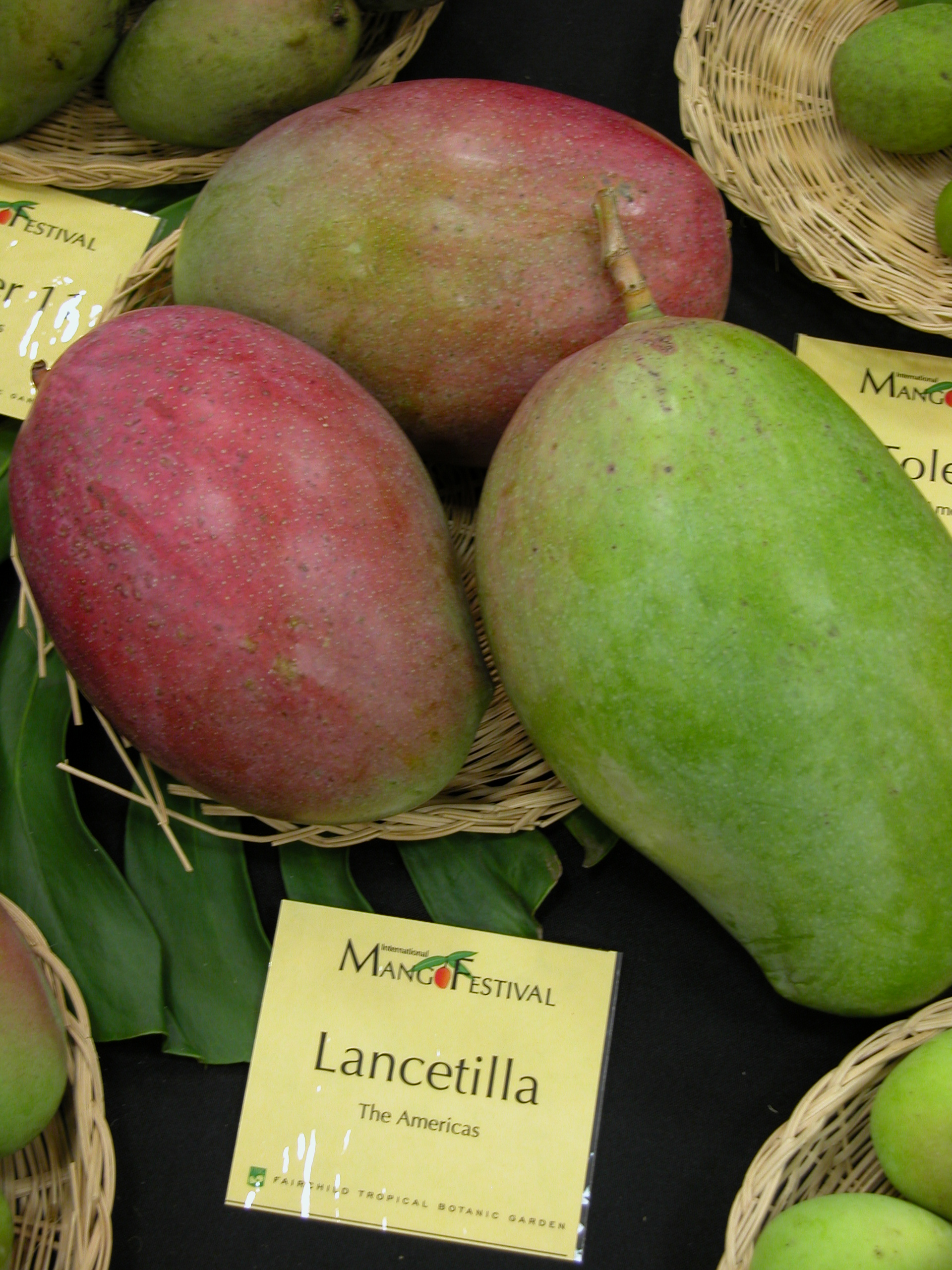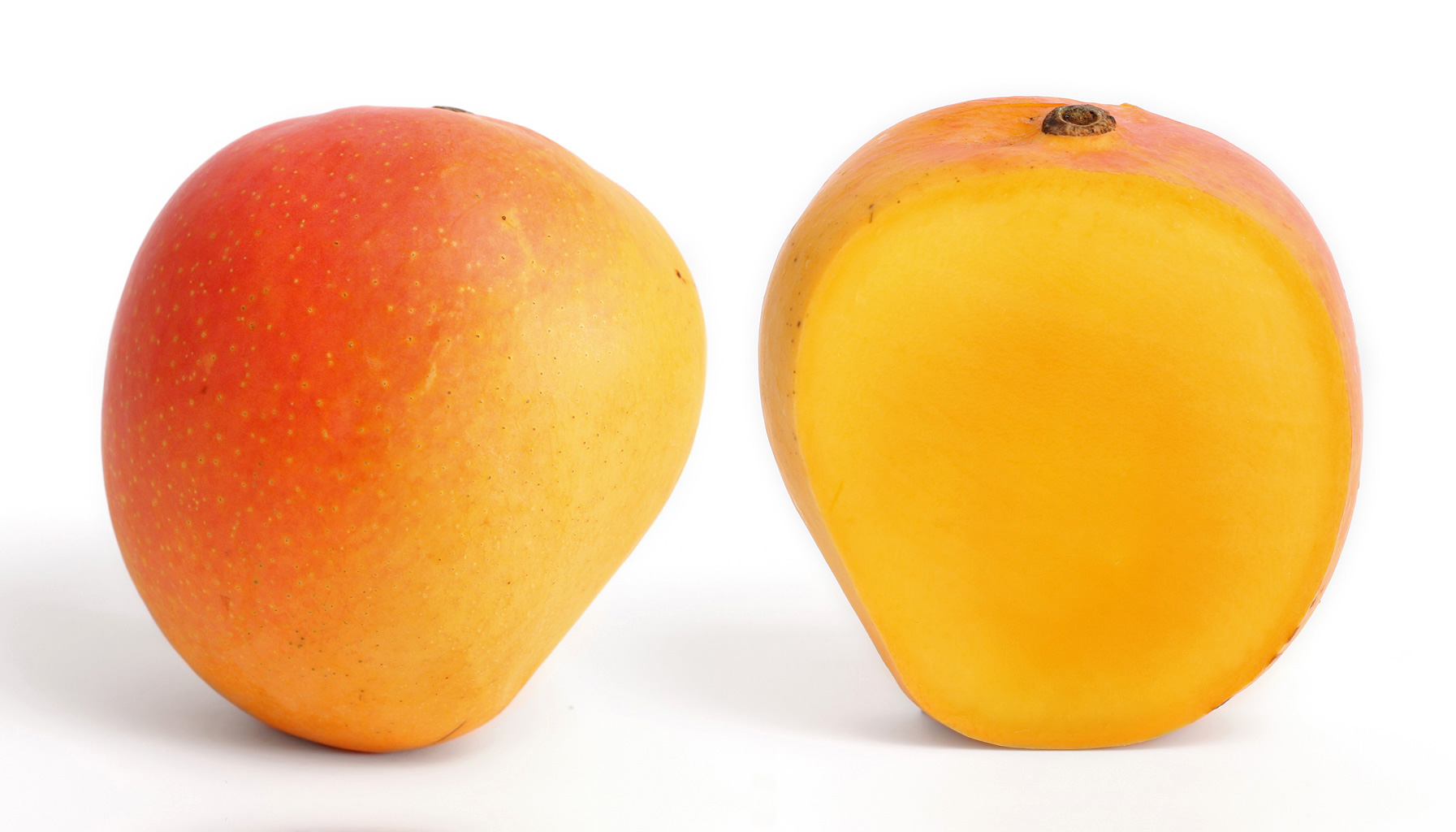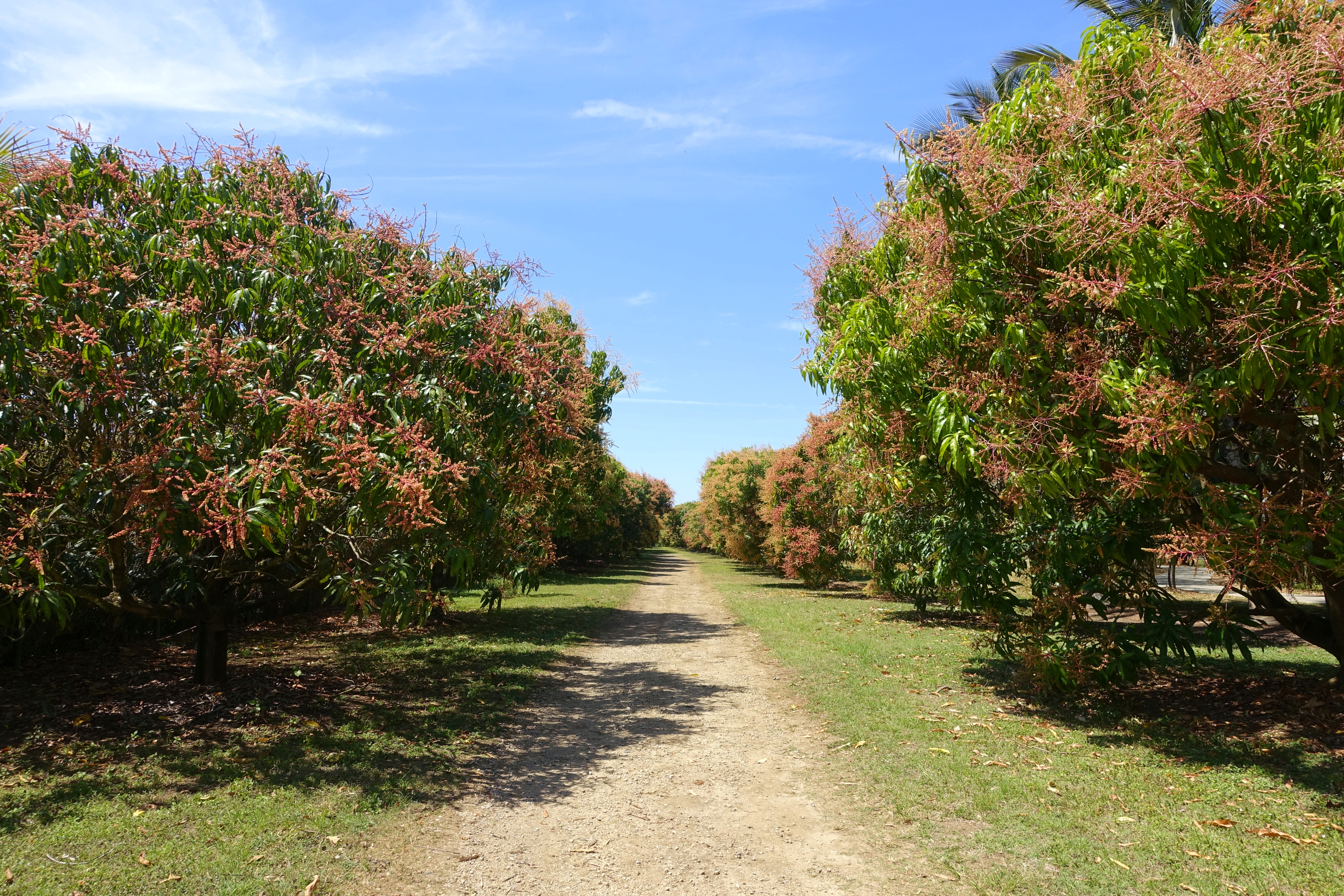|
Lancetilla
The 'Lancetilla' mango is a named mango cultivar that originated in Honduras. History The original tree is believed to have been the result of a cross between the Saigon and Mulgoba varieties by Wilson Popenoe, grown on his property in Lancetilla on the north coast of Honduras. Lancetilla was introduced to the United States via South Florida and first received notoriety at the Fairchild Tropical Botanic Garden's 2001 mango festival. The tree was promoted as a dooryard variety in Florida due to its excellent disease resistance and flavor, and is now widely sold as nursery stock in the state. A Lancetilla tree is planted in the collection of the Miami–Dade Redland Fruit & Spice Park in Homestead, Florida. Description The fruits are quite large at maturity, averaging around 2 pounds, some even weighing as much as 5 pounds. The skin color is red, and the fruit have a long, flattened oval shape. The flesh is lemon yellow in color, completely fiberless, and has a very sweet ... [...More Info...] [...Related Items...] OR: [Wikipedia] [Google] [Baidu] |
Mango Cultivar
The following is a list of some prominent mango cultivars. Worldwide, hundreds of mango cultivars are known, with over 1000 varieties in India. Most commercial cultivars belong to ''Mangifera indica'', while a few commercial varieties grown in Southeast Asia belong to other ''Mangifera'' species. Southeast Asia, Australia, the United States and some African countries cultivate locally selected varieties, while most other countries grow cultivars developed in Florida. Table of mangoes Reportedly, in India alone, there are around 283 types of mangoes, out of which only 30 are well-known. The United States Department of Agriculture (USDA) facility on Old Cutler Road in Coral Gables, Florida, has about 400 varieties of mangoes and is one of the largest depositories of mango plant cultures in the world. The USDA collection was originally believed to have over 500 varieties of mango germplasm, but genetic testing showed several duplicates. In the United States, South Florida is one o ... [...More Info...] [...Related Items...] OR: [Wikipedia] [Google] [Baidu] |
Mulgoba (mango)
''Malgova or Malgoa is an important mango cultivar mainly grown in Tamilnadu and Karnataka and also in other parts of South India. It is a large round fruit (typically 300-500 g), it has a small hard seed inside and is very juicy and fragrant. It is generally considered to be one of the best mangoes. Its production area is centred on the districts of Salem, Dharmapuri and Krishnagiri in Tamil Nadu, Gujarat, as well as neighbouring parts of Andhra Pradesh and Karnataka. A variety that was transplanted in Florida is called Mulgoba (very likely due to a mislabeling). A strain is also grown in Malaysia. The US variety is somewhat smaller, and may even be a different strain. A DNA analysis of 50 varieties of mango obtained several DNA clusters but found the Malgova to be the most distinct. Description ThMalgovais a round mango which retains a green colour (with hints of red) when ripe. It is roundish-oblique, in shape, with a blunt apex and has a smaller lateral beak than oth ... [...More Info...] [...Related Items...] OR: [Wikipedia] [Google] [Baidu] |
Fruit And Spice Park
The Fruit & Spice Park, formally known as the Preston B. Bird/Mary Heinlein Fruit & Spice Park, is a 37-acre park located in the heart of Redland, Florida, and is the only botanical garden of its kind in the United States. This park is operated by Miami-Dade County Parks and Open Spaces Department. The park in itself attracts more than 50,000 visitors a year because of its unique agricultural environment. The garden features more than 500 different types of international exotic fruits, vegetables, herbs, and spices. Visitors are allowed to sample fallen fruits, enjoy lunch at the Mango Cafe, or schedule a tour of the park. History The Redland area, part of southern Miami-Dade County, has always been known for its many farms, unique ability to grow fresh fruit, and its reddish soil. Mary Calkins Heinlein was the daughter of pioneer sub-tropical farmers and had always had a passion for fruits and gardens in South Florida. She had a goal to showcase the Redland and its rich agric ... [...More Info...] [...Related Items...] OR: [Wikipedia] [Google] [Baidu] |
Homestead, Florida
Homestead is a city within Miami-Dade County in the U.S. state of Florida, between Biscayne National Park to the east and Everglades National Park to the west. The population was 80,737 as of the 2020 census. Homestead is primarily a Miami suburb and a major agricultural area. It is a principal city of the Miami metropolitan area, which was home to an estimated 6,012,331 people at the 2015 census. It is located approximately southwest of Miami, and northwest of Key Largo. The city of Homestead is located near the southern terminus of the Homestead Extension of Florida's Turnpike where it ends at its junction with U.S. 1. Homestead is immediately north and east of Florida City, and these two cities comprise the greater Homestead-Florida City area. Some of the notable unincorporated communities in the area are Redland, Leisure City, Naranja, and Princeton. History Homestead was incorporated in 1913 and is the second oldest city in Miami-Dade County next to the city of ... [...More Info...] [...Related Items...] OR: [Wikipedia] [Google] [Baidu] |
Mangifera
''Mangifera'' is a genus of flowering plants in the cashew family, Anacardiaceae. It contains approximately 69 species, with the best-known being the Common Mango (''Mangifera indica''). The center of diversity of the genus is in the Malesian ecoregion of Southeast Asia; particularly in Sumatra, Borneo, and the Malay peninsula. They are generally canopy trees in lowland rainforests, reaching a height of . Uses ''Mangifera'' species are widely cultivated in Asia and elsewhere. More than 27 species in the genus bear edible, fleshy fruits, especially the Common Mango ('' M. indica''). Others, such as '' M. foetida'', yield astringent fruits that can be eaten pickled. Mango wastes, such as the seed kernel and peel, have high functional and nutritional potential. Mango seed contains important bioactive compounds that have high antioxidant activity, lipids that have acceptable physical and chemical characteristics (free of trans fatty acids), and a high protein content. The mango peel ... [...More Info...] [...Related Items...] OR: [Wikipedia] [Google] [Baidu] |
Saigon (mango)
The Saigon mango is a seedling race of mango cultivars originally introduced to the United States via seed from Southeast Asia. History Saigon seeds were shipped to the United States from Saigon, Cochinchina, in 1902 and planted at the USDA's plant introduction station in Miami, Florida, for observation. Edward Simmonds, the station's director, found the fruit to be of good quality Saigon trees mostly came true from seed, though there were some variation. This meant that multiple types of Saigon came into existence, and thus the name covers several varieties. Because of the positive qualities of the fruit, Saigon was utilized in Edward Simmonds hybridization experiment, which resulted in a cross between a Saigon and the Indian 'Amini' cultivar. The resulting cross was named 'Samini'. Saigon was also a parent of other mangoes in Florida as well, including the Florigon, whose name is a cross between the words "Florida" and "Saigon". Saigon was also claimed to be a parent of th ... [...More Info...] [...Related Items...] OR: [Wikipedia] [Google] [Baidu] |
Wilson Popenoe
Frederick Wilson Popenoe (March 9, 1892 – June 20, 1975) was an American Department of Agriculture employee and plant explorer. From 1916 to 1924, Popenoe explored Latin America to look for new strains of avocados. He reported his adventures to the ''National Geographic Society''. He went to work for the U.S. Department of Agriculture in 1913 and became the chief agronomist of the United Fruit Company in 1925. Career Popenoe attended Pomona College as a special student for one year. Afterwards, he worked for the United Fruit Company, where he became the first director of the Panamerican Agricultural School, Zamorano in Honduras. Popenoe won numerous awards and received three honorary doctorates, from: Universidad Mayor de San Marcos in Lima, Peru; Pomona College; and the University of Florida in Gainesville, Florida. Personal life Popenoe was married to the British archeologist Dorothy Popenoe, who was involved in excavation of the Playa de los Muertos in Honduras. ... [...More Info...] [...Related Items...] OR: [Wikipedia] [Google] [Baidu] |
Honduras
Honduras, officially the Republic of Honduras, is a country in Central America. The republic of Honduras is bordered to the west by Guatemala, to the southwest by El Salvador, to the southeast by Nicaragua, to the south by the Pacific Ocean at the Gulf of Fonseca, and to the north by the Gulf of Honduras, a large inlet of the Caribbean Sea. Its capital and largest city is Tegucigalpa. Honduras was home to several important Mesoamerican cultures, most notably the Maya, before the Spanish Colonization in the sixteenth century. The Spanish introduced Catholicism and the now predominant Spanish language, along with numerous customs that have blended with the indigenous culture. Honduras became independent in 1821 and has since been a republic, although it has consistently endured much social strife and political instability, and remains one of the poorest countries in the Western Hemisphere. In 1960, the northern part of what was the Mosquito Coast was transferred from Nicara ... [...More Info...] [...Related Items...] OR: [Wikipedia] [Google] [Baidu] |
South Florida
South Florida is the southernmost region of the U.S. state of Florida. It is one of Florida's three most commonly referred to directional regions; the other two are Central Florida and North Florida. South Florida is the southernmost part of the continental United States and the only region of the continental U.S. that includes some areas with a tropical climate. South Florida is dominated by the Miami metropolitan area and the Everglades, and contains the Florida Keys, three U.S. national parks (namely Biscayne, Dry Tortugas, and Everglades), and multiple cities. While the term most commonly refers to the Keys and Greater Miami, interpretations vary on the inclusion of some other parts of Florida within the South Florida region, most commonly the southern parts of the Tampa Bay area, the inclusion of Southwest Florida and its cities, and the Treasure Coast. Composition As with all vernacular regions, South Florida has no official boundaries or status and is defined different ... [...More Info...] [...Related Items...] OR: [Wikipedia] [Google] [Baidu] |
Mango Lancetilla Asit Ftg
A mango is an edible stone fruit produced by the tropical tree ''Mangifera indica''. It is believed to have originated in the region between northwestern Myanmar, Bangladesh, and northeastern India. ''M. indica'' has been cultivated in South and Southeast Asia since ancient times resulting in two types of modern mango cultivars: the "Indian type" and the "Southeast Asian type". Other species in the genus ''Mangifera'' also produce edible fruits that are also called "mangoes", the majority of which are found in the Malesian ecoregion. Worldwide, there are several hundred cultivars of mango. Depending on the cultivar, mango fruit varies in size, shape, sweetness, skin color, and flesh color which may be pale yellow, gold, green, or orange. Mango is the national fruit of India, Pakistan and the Philippines, while the mango tree is the national tree of Bangladesh. Etymology The English word ''mango'' (plural "mangoes" or "mangos") originated in the 16th century from the Port ... [...More Info...] [...Related Items...] OR: [Wikipedia] [Google] [Baidu] |
Monoembryonic
Monoembryony is the emergence of one and only one seedling from a seed. A seed giving two or more seedlings is polyembryonic. Some of the nuclear cells surrounding the embryo sac In seed plants, the ovule is the structure that gives rise to and contains the female reproductive cells. It consists of three parts: the ''integument'', forming its outer layer, the ''nucellus'' (or remnant of the megasporangium), and the fe ... start dividing and protrude into the embryo sac and develop into embryos. American Journal of Botany 98(10): 1613–1622. 2011. https://bsapubs.onlinelibrary.wiley.com/doi/epdf/10.3732/ajb.1100022 References Plant reproduction Embryology {{developmental-biology-stub ... [...More Info...] [...Related Items...] OR: [Wikipedia] [Google] [Baidu] |






